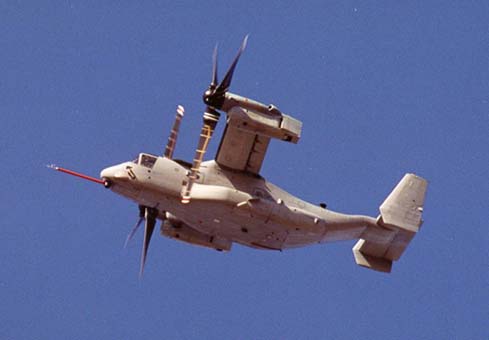
| V-22 Osprey Specifications |
| Primary Function: | Amphibious assault transport of troops, equipment and supplies from assault ships and land bases | | Contractor: | Boeing Defense and Space Group, Philadelphia, PA; Bell Helicopter Textron, Ft Worth, TX; Allison Engine Company, Indianapolis, IN | | Crew: | N/A | | Unit Cost: | $40.1M (Total Program Recurring Flyaway, Constant Year, FY94$) | | Powerplant | | | Two Allison T406-AD-400 turboshafts each rated at 6,150 shp (4586 kW) take-off and 5,890 shp (4392 kw) continuous running. | | Dimensions | | Length: | 57' 4 inches - Spread
63 feet 0 inches - Folded | | Width: | 84' 7 inches - Spread
18 feet 5 inches - Folded | | Height: | 22 feet 1 inches - Spread
18 feet 1 inches - Folded | | Weights | | Empty: | 31,886 lb (14463 kg) -- equipped | | Maximum Takeoff: | 60,000 lb (27442 kg) -- for STO | | Performance | | Speed: | 316 mph (509 km/h / 275 kt) -- airplane mode
115 mph (185 km/h / 100 kt) -- helicopter mode | | Ceiling: | 26,000 feet (7925 m) | | Range: | 200nm Pre-Assault Raid with 18 troops
200nm Land Assault with 24 troops | | Armament | | | N/A | |
V-22 Osprey Achievements - The V-22 is the world's first production tiltrotor aircraft.
V-22 Osprey Features The Osprey is a tiltrotor aircraft with a 38-foot rotor system and engine/transmission nacelle mounted on each wing tip. It can operate as a helicopter when taking off and landing vertically. Once airborne, the nacelles rotate forward 90 degrees for horizontal flight, converting the V-22 to a high-speed, fuel-efficient turboprop airplane. The wing rotates for compact storage aboard ship. The first flight occurred in March 1989. The V-22 is the world's first production tiltrotor aircraft. Planned purchases include 360 for the Marine Corps, 48 for the Navy and 50 for the Air Force.
V-22 Osprey Background Bell Helicopter and Boeing Vertol joined forces during the early 1980s to develop a larger scale aircraft of the XV-15 tilt-rotor demonstrator program for the Joint Services Advanced Vertical Lift Aircraft program, which combined the vertical takeoff capabilities of a helicopter and the efficiencies of a fixed-wing aircraft. The V-22 was awarded with full-scale development in 1985. Flight testing of the V-22 started on March 19, 1989, and it successfully demonstrated airborne transition from helicopter to wing-borne flight in September 1989.
V-22 Osprey Photos










No comments:
Post a Comment